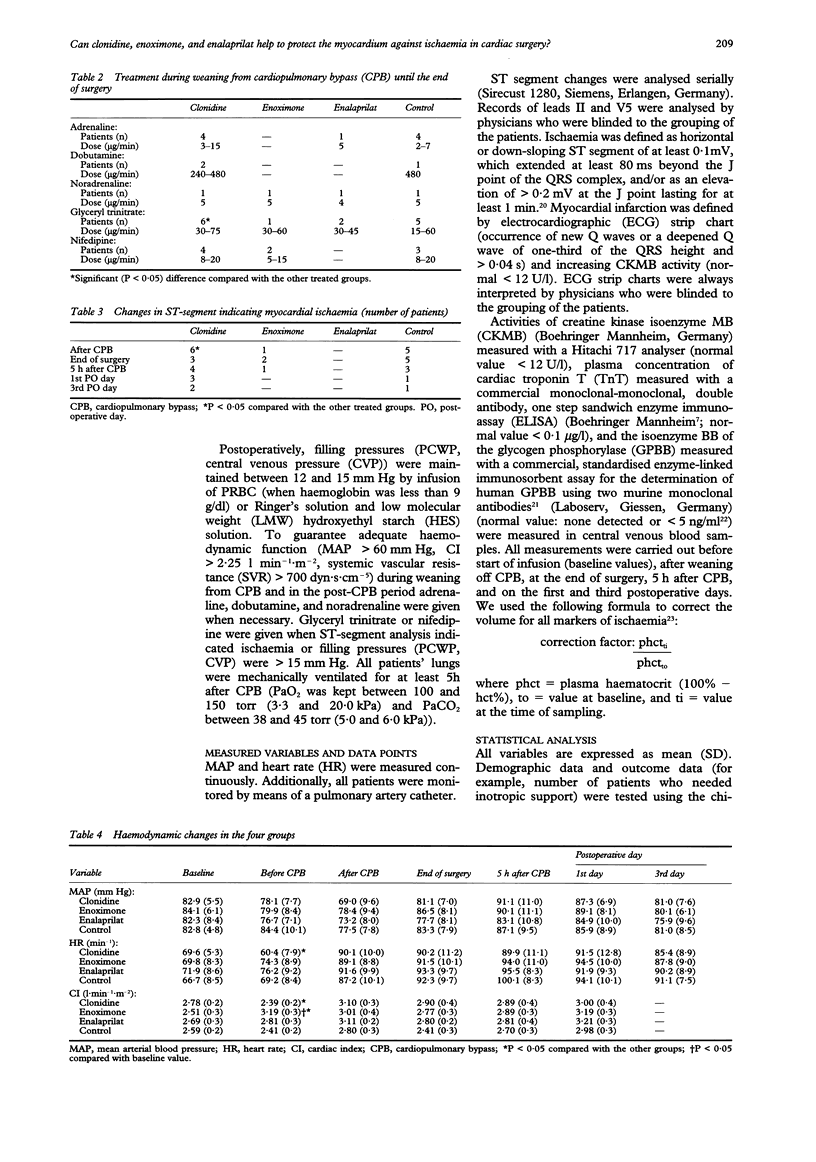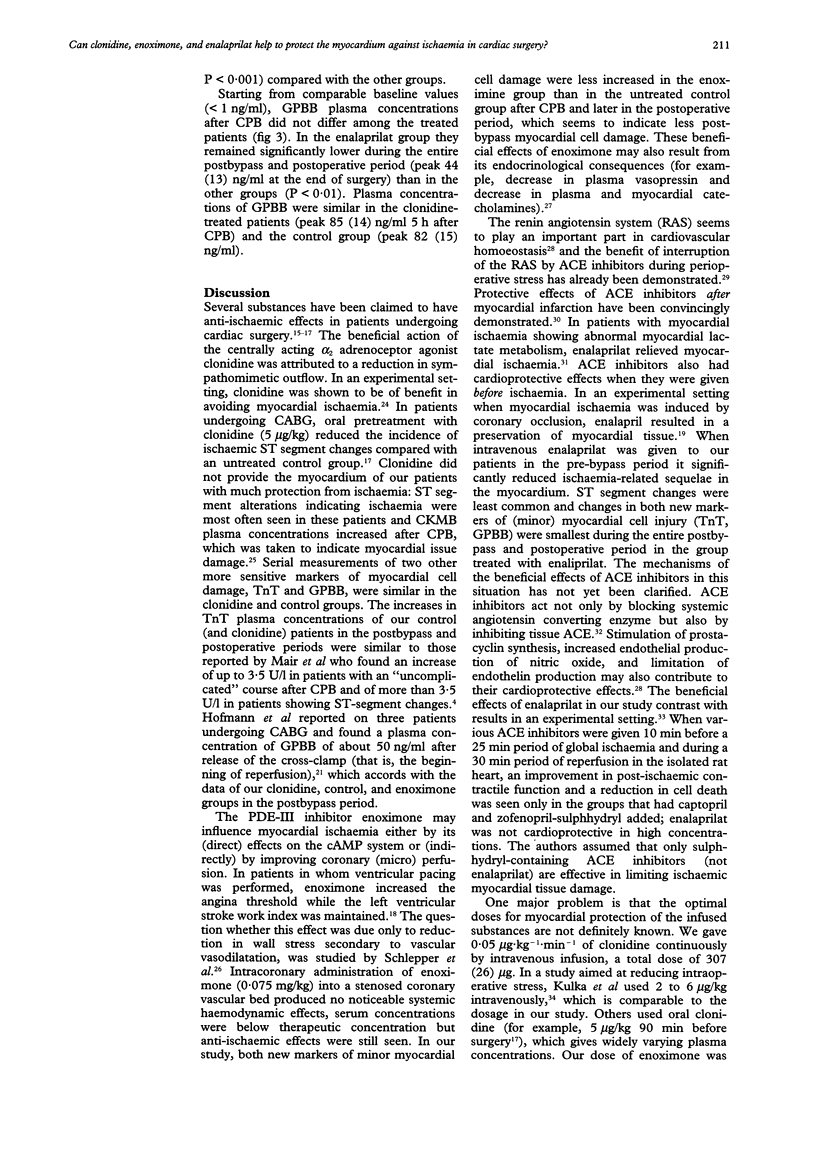Abstract
OBJECTIVE: To evaluate whether clonidine, enoximone, and enalaprilat reduce ischaemia-related myocardial cell damage in cardiac surgery. DESIGN: Prospective randomised controlled trial. SETTING: Clinical investigation in a cardiac anaesthesia department of a university hospital. PATIENTS: 88 consecutive patients undergoing coronary artery bypass surgery. INTERVENTIONS: After induction of anaesthesia patients continuously received the alpha 2 agonist clonidine (group 1, n = 22), the phosphodiesterase (PDE) III inhibitor enoximone (group 2, n = 22), the angiotensin converting enzyme (ACE) inhibitor enalaprilat (group 3, n = 22), or saline solution as placebo (control group, n = 22). The infusion was stopped immediately before the start of cardiopulmonary bypass. MAIN OUTCOME MEASURES: The ST segment was analysed and the activity of creatine kinase isoenzyme MB (CKMB), cardiac troponin T (TnT), and the BB isoenzyme of glycogen phosphorylase (GPBB) were measured before the start of infusion (baseline), after weaning from cardiopulmonary bypass (CPB), at the end of surgery, 5 h after CPB, and on the morning of the first and third postoperative days. RESULTS: Biometric data and time of cross-clamping were not significantly different in the four groups. Changes in the ST segment indicating ischaemia were least common in the enalaprilat group (P < 0.05). Postoperatively, CKMB activity was significantly higher in the clonidine and the control groups. Both new markers of myocardial cell damage increased more after CPB and postoperatively in the control patients (TnT peak: (mean (SD)) 3.99 (0.35) microgram/1; GPBB peak: 82 (15) ng/ml) and the clonidine-treated group (TnT peak: 3.80 (0.3) microgram/1; GPBB peak: 85 (14) ng/ml). Enalaprilat-treated patients showed the smallest overall changes in standard (CKMB) and new serological markers of myocardial ischaemia (TnT peak: 0.71 (0.1) microgram/1; GPBB peak: 44 (14) ng/ml). CONCLUSIONS: In patients treated with enalaprilat before CPB, both new, more sensitive markers of ischaemic myocardial tissue damage increased significantly less than in an untreated control group. Those treated with enoximone also had lower plasma concentration of TnT and GPBB than the control group, whereas clonidine did not reduce the concentration of these markers of myocardial ischaemia. Pharmacological interventions, such as the continuous infusion of the ACE inhibitor enalaprilat, before start of CPB may help to protect the heart against ischaemia/reperfusion injury.
Full text
PDF






Images in this article
Selected References
These references are in PubMed. This may not be the complete list of references from this article.
- Adams J. E., 3rd, Abendschein D. R., Jaffe A. S. Biochemical markers of myocardial injury. Is MB creatine kinase the choice for the 1990s? Circulation. 1993 Aug;88(2):750–763. doi: 10.1161/01.cir.88.2.750. [DOI] [PubMed] [Google Scholar]
- Balderman S. C., Bhayana J. N., Steinbach J. J., Masud A. R., Michalek S. Perioperative myocardial infarction: a diagnostic dilemma. Ann Thorac Surg. 1980 Oct;30(4):370–377. doi: 10.1016/s0003-4975(10)61277-5. [DOI] [PubMed] [Google Scholar]
- Bolling S. F., Groh M. A., Mattson A. M., Grinage R. A., Gallagher K. P. Acadesine (AICA-riboside) improves postischemic cardiac recovery. Ann Thorac Surg. 1992 Jul;54(1):93–98. doi: 10.1016/0003-4975(92)91148-3. [DOI] [PubMed] [Google Scholar]
- Chatterjee K., De Marco T. Systemic and coronary haemodynamics and pharmacodynamics of enalapril and enalaprilat in congestive heart failure. Drugs. 1990;39 (Suppl 4):29–42. doi: 10.2165/00003495-199000394-00007. [DOI] [PubMed] [Google Scholar]
- Colson P. Angiotensin-converting enzyme inhibitors in cardiovascular anesthesia. J Cardiothorac Vasc Anesth. 1993 Dec;7(6):734–742. doi: 10.1016/1053-0770(93)90063-q. [DOI] [PubMed] [Google Scholar]
- Davis M. E., Jones C. J., Feneck R. O., Walesby R. K. The effects of intravenous nitroglycerin and isosorbide dinitrate on hemodynamics and myocardial metabolism. J Cardiothorac Anesth. 1989 Dec;3(6):712–719. doi: 10.1016/s0888-6296(89)94684-x. [DOI] [PubMed] [Google Scholar]
- DiPette D. J., Ferraro J. C., Evans R. R., Martin M. Enalaprilat, an intravenous angiotensin-converting enzyme inhibitor, in hypertensive crises. Clin Pharmacol Ther. 1985 Aug;38(2):199–204. doi: 10.1038/clpt.1985.159. [DOI] [PubMed] [Google Scholar]
- Dzau V. J. Circulating versus local renin-angiotensin system in cardiovascular homeostasis. Circulation. 1988 Jun;77(6 Pt 2):I4–13. [PubMed] [Google Scholar]
- Entman M. L., Bornet E. P., Van Winkle W. B., Goldstein M. A., Schwartz A. Association of glycogenolysis with cardiac sarcoplasmic reticulum: II. Effect of glycogen depletion, deoxycholate solubilization and cardiac ischemia: evidence for a phorphorylase kinase membrane complex. J Mol Cell Cardiol. 1977 Jul;9(7):515–528. doi: 10.1016/s0022-2828(77)80367-2. [DOI] [PubMed] [Google Scholar]
- Feindt P., Volkmer I., Seyfert U. T., Haack H. The role of protein C as an inhibitor of blood clotting during extracorporeal circulation. Thorac Cardiovasc Surg. 1991 Dec;39(6):338–343. doi: 10.1055/s-2007-1019995. [DOI] [PubMed] [Google Scholar]
- Flacke J. W. Alpha 2-adrenergic agonists in cardiovascular anesthesia. J Cardiothorac Vasc Anesth. 1992 Jun;6(3):344–359. doi: 10.1016/1053-0770(92)90156-2. [DOI] [PubMed] [Google Scholar]
- Gerhardt W., Katus H., Ravkilde J., Hamm C., Jørgensen P. J., Peheim E., Ljungdahl L., Löfdahl P. S-troponin T in suspected ischemic myocardial injury compared with mass and catalytic concentrations of S-creatine kinase isoenzyme MB. Clin Chem. 1991 Aug;37(8):1405–1411. [PubMed] [Google Scholar]
- Grover G. J., Sleph P. G., Dzwonczyk S., Wang P., Fung W., Tobias D., Cushman D. W. Effects of different angiotensin-converting enzyme (ACE) inhibitors on ischemic isolated rat hearts: relationship between cardiac ACE inhibition and cardioprotection. J Pharmacol Exp Ther. 1991 Jun;257(3):919–929. [PubMed] [Google Scholar]
- Heusch G., Schipke J., Thämer V. Clonidine prevents the sympathetic initiation and aggravation of poststenotic myocardial ischemia. J Cardiovasc Pharmacol. 1985 Nov-Dec;7(6):1176–1182. doi: 10.1097/00005344-198511000-00026. [DOI] [PubMed] [Google Scholar]
- Hock C. E., Ribeiro L. G., Lefer A. M. Preservation of ischemic myocardium by a new converting enzyme inhibitor, enalaprilic acid, in acute myocardial infarction. Am Heart J. 1985 Feb;109(2):222–228. doi: 10.1016/0002-8703(85)90587-3. [DOI] [PubMed] [Google Scholar]
- Katus H. A., Looser S., Hallermayer K., Remppis A., Scheffold T., Borgya A., Essig U., Geuss U. Development and in vitro characterization of a new immunoassay of cardiac troponin T. Clin Chem. 1992 Mar;38(3):386–393. [PubMed] [Google Scholar]
- Katus H. A., Schoeppenthau M., Tanzeem A., Bauer H. G., Saggau W., Diederich K. W., Hagl S., Kuebler W. Non-invasive assessment of perioperative myocardial cell damage by circulating cardiac troponin T. Br Heart J. 1991 May;65(5):259–264. doi: 10.1136/hrt.65.5.259. [DOI] [PMC free article] [PubMed] [Google Scholar]
- Kulka P. J., Tryba M., Zenz M. Dose-response effects of intravenous clonidine on stress response during induction of anesthesia in coronary artery bypass graft patients. Anesth Analg. 1995 Feb;80(2):263–268. doi: 10.1097/00000539-199502000-00011. [DOI] [PubMed] [Google Scholar]
- Lee T. H., Goldman L. Serum enzyme assays in the diagnosis of acute myocardial infarction. Recommendations based on a quantitative analysis. Ann Intern Med. 1986 Aug;105(2):221–233. doi: 10.7326/0003-4819-105-2-221. [DOI] [PubMed] [Google Scholar]
- Mair J., Artner-Dworzak E., Lechleitner P., Smidt J., Wagner I., Dienstl F., Puschendorf B. Cardiac troponin T in diagnosis of acute myocardial infarction. Clin Chem. 1991 Jun;37(6):845–852. [PubMed] [Google Scholar]
- Mair J., Puschendorf B., Smidt J., Lechleitner P., Dienstl F., Noll F., Krause E. G., Rabitzsch G. Early release of glycogen phosphorylase in patients with unstable angina and transient ST-T alterations. Br Heart J. 1994 Aug;72(2):125–127. doi: 10.1136/hrt.72.2.125. [DOI] [PMC free article] [PubMed] [Google Scholar]
- Michael L. H., Hunt J. R., Weilbaecher D., Perryman M. B., Roberts R., Lewis R. M., Entman M. L. Creatine kinase and phosphorylase in cardiac lymph: coronary occlusion and reperfusion. Am J Physiol. 1985 Mar;248(3 Pt 2):H350–H359. doi: 10.1152/ajpheart.1985.248.3.H350. [DOI] [PubMed] [Google Scholar]
- Mitrovic V., Thormann J., Neuzner J., Bahawar H., Volz M., Dieterich H. A., Schlepper M. Hemodynamic, antiischemic, and neurohumoral effects of enoximone in patients with coronary artery disease. Am Heart J. 1989 Jan;117(1):106–111. doi: 10.1016/0002-8703(89)90663-7. [DOI] [PubMed] [Google Scholar]
- Murphy J. D., Vaughan R. S., Rosen M. Intravenous enalaprilat and autonomic reflexes. The effects of enalaprilat on the cardiovascular responses to postural changes and tracheal intubation. Anaesthesia. 1989 Oct;44(10):816–821. doi: 10.1111/j.1365-2044.1989.tb09098.x. [DOI] [PubMed] [Google Scholar]
- Rabitzsch G., Mair J., Lechleitner P., Noll F., Hofmann V., Krause E. G., Dienstl F., Puschendorf B. Isoenzyme BB of glycogen phosphorylase b and myocardial infarction. Lancet. 1993 Apr 17;341(8851):1032–1033. doi: 10.1016/0140-6736(93)91129-a. [DOI] [PubMed] [Google Scholar]
- Rabitzsch G., Noll F., Hofmann U., Krause E. G., Armbruster F. P. Basal concentration of the isoenzyme BB of the glycogen phosphorylase b in human blood. Clin Chim Acta. 1993 Jan 31;214(1):109–111. doi: 10.1016/0009-8981(93)90309-r. [DOI] [PubMed] [Google Scholar]
- Schlepper M., Thormann J., Mitrovic V. Cardiovascular effects of forskolin and phosphodiesterase-III inhibitors. Basic Res Cardiol. 1989;84 (Suppl 1):197–212. doi: 10.1007/BF02650360. [DOI] [PubMed] [Google Scholar]
- Seitelberger R., Zwölfer W., Binder T. M., Huber S., Peschl F., Spatt J., Schwarzacher S., Holzinger C., Coraim F., Weber H. Infusion of nifedipine after coronary artery bypass grafting decreases the incidence of early postoperative myocardial ischemia. Ann Thorac Surg. 1990 Jan;49(1):61–68. doi: 10.1016/0003-4975(90)90357-c. [DOI] [PubMed] [Google Scholar]
- Sigurdsson A., Held P., Andersson G., Swedberg K. Enalaprilat in acute myocardial infarction: tolerability and effects on the renin-angiotensin system. Int J Cardiol. 1991 Oct;33(1):115–124. doi: 10.1016/0167-5273(91)90159-m. [DOI] [PubMed] [Google Scholar]
- Slogoff S., Keats A. S. Further observations on perioperative myocardial ischemia. Anesthesiology. 1986 Nov;65(5):539–542. doi: 10.1097/00000542-198611000-00020. [DOI] [PubMed] [Google Scholar]
- Smith R. C., Leung J. M., Mangano D. T. Postoperative myocardial ischemia in patients undergoing coronary artery bypass graft surgery. S.P.I. Research Group. Anesthesiology. 1991 Mar;74(3):464–473. doi: 10.1097/00000542-199103000-00013. [DOI] [PubMed] [Google Scholar]
- Thomson I. R. Con: intraoperative myocardial ischemia is not benign. J Cardiothorac Vasc Anesth. 1994 Oct;8(5):593–595. doi: 10.1016/1053-0770(94)90177-5. [DOI] [PubMed] [Google Scholar]
- Thürmann P., Rietbrock N. Current concepts: converting enzyme inhibitors in coronary artery disease. Clin Investig. 1992 Jan;70(1):70–76. doi: 10.1007/BF00422945. [DOI] [PubMed] [Google Scholar]
- Weber K. T., Janicki J. S., Jain M. C. Enoximone (MDL 17,043), a phosphodiesterase inhibitor, in the treatment of advanced, unstable chronic heart failure. J Heart Transplant. 1986 Mar-Apr;5(2):105–112. [PubMed] [Google Scholar]



